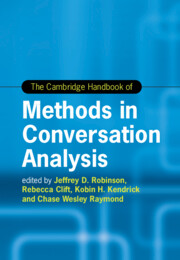Book contents
- Frontmatter
- Contents
- List of Tables
- List of Contributors
- Part I Introduction
- Part II Points of Departure
- Part III Collections
- 8 Working with Collections in Conversation Analysis
- 9 Working with Data II: Clips and Collections
- 10 History of a Collection: Repetition Repairs
- 11 The History of a Collection: Apologies
- 12 Developing a Collection: Coordination of Embodied Conduct with Darf/Kann ich X? ‘May/Can I …?’ in German
- Part IV Evidence
- Part V Avenues into Action
- Part VI Situating and Reporting Findings
- Part VII Looking Forward
- Appendix I Jeffersonian Transcription Conventions
- Appendix II Multimodal Transcription Conventions
- Index
9 - Working with Data II: Clips and Collections
from Part III - Collections
Published online by Cambridge University Press: 06 December 2024
- Frontmatter
- Contents
- List of Tables
- List of Contributors
- Part I Introduction
- Part II Points of Departure
- Part III Collections
- 8 Working with Collections in Conversation Analysis
- 9 Working with Data II: Clips and Collections
- 10 History of a Collection: Repetition Repairs
- 11 The History of a Collection: Apologies
- 12 Developing a Collection: Coordination of Embodied Conduct with Darf/Kann ich X? ‘May/Can I …?’ in German
- Part IV Evidence
- Part V Avenues into Action
- Part VI Situating and Reporting Findings
- Part VII Looking Forward
- Appendix I Jeffersonian Transcription Conventions
- Appendix II Multimodal Transcription Conventions
- Index
Summary
Conversation Analysis usually involves collecting, organizing, and analyzing audiovisual data clips and transcripts. In this chapter, we provide guidance based on common CA research practices for making, naming, and organizing clips. We provide examples of both digital and analog tools and methods for preparing, manipulating, and reviewing transcripts and data throughout the analytic research cycle. Finally, we discuss common data management techniques for protecting participant privacy by masking voices, faces, and other identifiable features before sharing clips and transcripts e.g., during CA data sessions. This chapter aims to support CA researchers who have already collected and organized their field recordings, and are ready to start making, sharing, and analyzing collections of clips.
Keywords
Information
- Type
- Chapter
- Information
- The Cambridge Handbook of Methods in Conversation Analysis , pp. 217 - 233Publisher: Cambridge University PressPrint publication year: 2024
Accessibility standard: Unknown
Why this information is here
This section outlines the accessibility features of this content - including support for screen readers, full keyboard navigation and high-contrast display options. This may not be relevant for you.Accessibility Information
- 1
- Cited by
